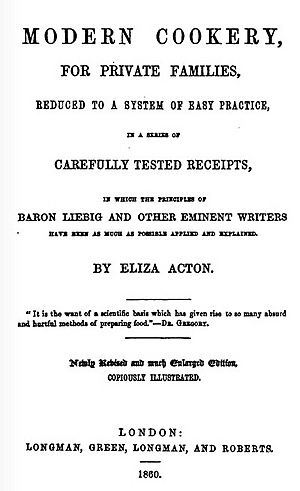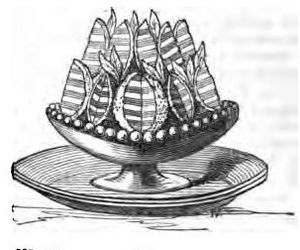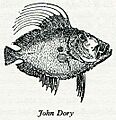Modern Cookery for Private Families facts for kids

Title Page of 1860 edition
|
|
| Author | Eliza Acton |
|---|---|
| Country | England |
| Subject | English cooking |
| Genre | Cookery |
| Publisher | Longmans |
|
Publication date
|
1847 |
Modern Cookery for Private Families is a famous English cookery book written by Eliza Acton. It was first published in 1845 and quickly became a huge success. Many people bought it, and it was printed 13 times by 1853!
This book was special because it was one of the first to clearly list ingredients, exact amounts, and cooking times for recipes. It also included recipes from Eastern places, like for chutneys. Famous cooks like Delia Smith and Elizabeth David have praised Eliza Acton's writing and recipes. They thought she was one of the best recipe writers ever.
Contents
About the Cookery Book
Eliza Acton spent several years researching for Modern Cookery. Many recipes came from her friends. The book became a bestseller and stayed popular for many years. It changed how cookery books were written.
Before this book, cookbooks were not very clear. Acton's book was different. It listed the exact ingredients you needed. It also told you how long to cook things. This made it much easier for people to follow recipes at home.
The book was also one of the first to include recipes for Eastern "chatneys". These included fresh ones, like a "Mauritian shrimp chatney" with lemon. It also had preserved ones, like "Bengal chatney" with raisins and crab apples. Some people say this book was the first to use the name "Christmas pudding" in its 1845 edition. Before that, it was just called plum pudding.
Acton's recipe for mincemeat (used in mince pies) still had meat in it. She suggested using ox tongue or beef sirloin. She mixed this with lemons that were boiled until very soft.
Modern Cookery was printed for over 50 years. But later, Mrs Beeton's book, published in 1861, became even more famous.
How the Book Was Written
Acton's book is divided into chapters with simple names like "Fish." Unlike older cookbooks, these chapters were written like connected stories. For example, the chapter on fish starts with tips on how to pick fresh fish. Then it gives advice on baking and frying fish.
The recipes themselves are also written like stories. They are not just simple instructions. Where needed, recipes list ingredients and cooking times. This was a big change from older books. Recipes are grouped together, for example, by the type of fish.
Acton also added her own comments. She would say when food was in season. She might also say where a recipe came from. She even shared how much she liked a dish.
For example, for the John Dory fish, she wrote an introduction. It explained how to cook it simply. She said it was best from September to December.
-
- The John Dory is a very delicious fish. It is not very pretty to look at. Many people think it is almost as good as turbot. It is not found as often in our waters. You can tell it by its yellow-gray color. It has one large dark spot on each side. It also has long threads on its back. Its head is quite ugly. You cook it like a turbot. It needs less time to boil. Cut off the fins before cooking.
She then gave a simple recipe for baking small John Dories. She even added her own note saying, "Author's Receipt—good."
-
- We found these fish to be excellent when baked simply. This is especially true if they are too small to cook in the usual way. The meat is very sweet and tender. It is much better than when fried. Clean the fish and dry them with a cloth. Put a little salt inside. Sprinkle some flour on the fish. Add a few tiny bits of butter. This stops them from drying out in the oven. Lay them on a flat dish. Bake them gently for 14 to 16 minutes. Serve with the same sauce as baked soles.
- When the fish is very fresh, baking it simply is better. This is true even compared to more complex ways. You can make the John Dories look better. Just take off their heads. Also, cut away the fins and the threads on their back.
Pictures in the Book
From its first edition, the book had many small woodcut pictures. Some pictures showed cooking tools. For example, there was a pot for serving soup. There was also a "Mackerel Kettle" for cooking fish.
Other pictures showed food as a housekeeper would see it at the market. These included drawings of poultry and different fish. This helped readers learn to recognize fish like gurnard, sea bream, and plaice. Some pictures even showed finished dishes. For example, there was a picture of a moulded jelly. It was "tastefully garnished with preserved, or with fresh fruit."
Different Versions of the Book
The book was printed many times during the Victorian era. The title changed a little over the years.
| Editions |
|---|
|
Images for kids





